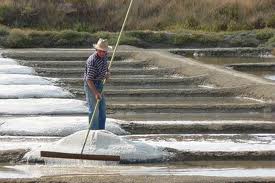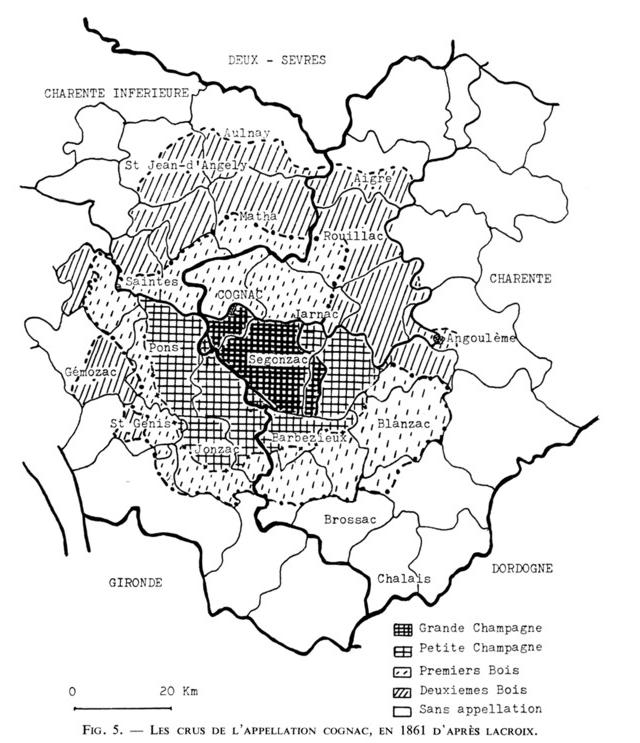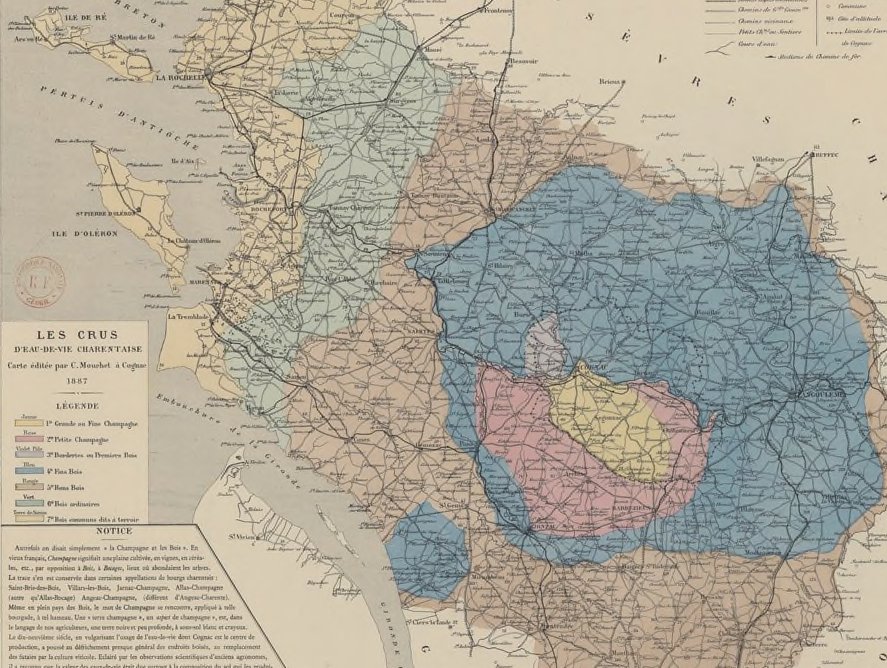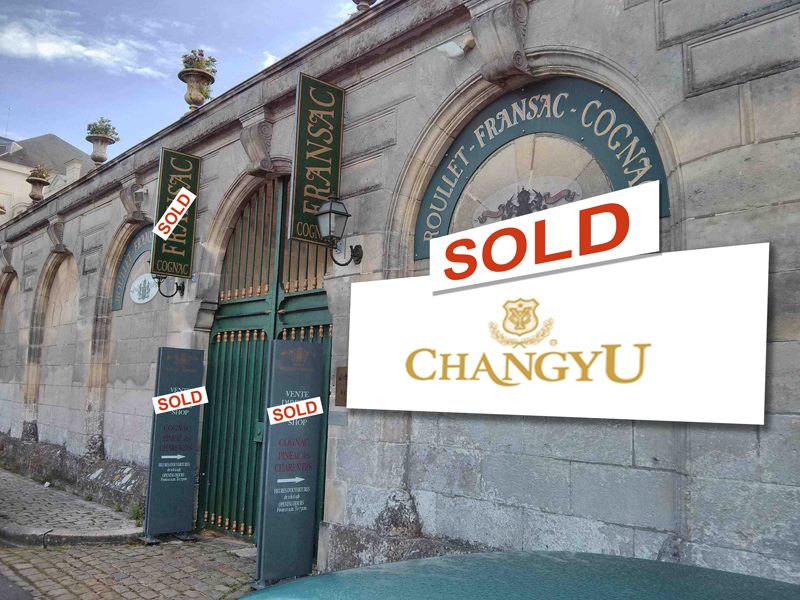The history of Cognac
When does the history of cognac begins? Many writers start in the first century of our calendar, because in this era viticulture started in France. They pay a lot of attention to the Roman occupation for two reasons: they brought the wineplant and they controlled if viticulture was to be permitted. In 92 AD emperor Titus Flavius Domitianus forbid the growing of wine and in 280 AD emperor Marcus Aurelius Probus lifted this ban. The other reason is that the Romans taught the Gauls in the 3th-4th century how to win salt in large quantities. The salt was very valuable and therefore attracted foreign ships.
The salt trade has been of eminent importance to the inhabitants of the coastal regions of Charente for centuries. The foreigners also came to discover and appreciate the wines of Charente and in the late Medieval period (1270-1500) wine had become a major source of income for the people of Charente, especially because salt had become less popular (The Portuguese salt was much more white and therefore more appealing.) Many foreign ships, English, Dutch, Scandinavian, came in search for wine. The wine was of good quality and initially able to endure the long time it had to spent in barrels during the voyage on sea before it could be drunk.
For me this period (late Medieval) is the starting point of the history of cognac. Distilling was by no means common practice, and certainly not in Charente. In other regions of France distilling did take place and even was there a guild of distillers in the beginning of the 16th century in Colmar. But in Charente people focussed on wine, which generated enough income. Some distillation did take place, but only in very small quantities. Besides, the method of distillation that has made cognac famous, the double distillation or distillation Charentaise, was not yet invented.
But slowly problems arised. Because of the Religious Wars a lot of vineyards were destroyed and had to be replanted. Influenced by the Dutch other grape varieties with greater yield were chosen. These varieties were of less quality en gave more acidic wines. So on the one hand production increased and on the other hand quality decreased. The result was a surplus of wine that could not be sold. And another problem emerged: these wines were no longer able to sustain the long journeys to their oversees destinations. They turned sour and became undrinkable. This of course led to complaints from abroad. One solution was to distil the wine. This kept it from going bad and had the additional advantage that it could be transported in smaller volumes. Once arrived they were again diluted with water. Although an interesting idea, it did not work. The result was terrible and the wines did not taste of wine at all anymore. How could they be thinking that watering down the distillate could bring back the original product?
All of this was happening at the beginning of the 17th century.
There were other problems too, like the high taxes. Especially the transportation of wine on the river Charente was being taxed dearly, as a result of which the wine-growers around Cognac and Jarnac had a big disadvantage in comparison with their colleagues nearer to the sea and the sea-harbours. This was another reason for the low sales of wines and contributed to the reasons that led to the increase of distillation: lower volumes and therefore lower taxes.
From 1600 onwards distillation gradually increased. Approximately 1600 was the period of the discovery and development of double distillation. According to a legend, knight De la Croix Marron was responsible for this discovery, being inspired by a dream. And although the French have clinged on to this story for a long time, even they admit now that it is not more than a legend.
Another discovery was being made. The distilled wine that was being transported in wooden barrels, gained in quality when being stored in wood for a longer span of time. Its taste mellowed and it obtained a pale colour under the influence of the wood. Hence the term that we still use nowadays: VSOP, very superior old pale.
These developments contributed to distilling becoming more and more popular in Charente. In 1617 we find the first mentioning (preserved in history) of brandy of good quality guaranteed to be from Cognac. There are other reports of sales of brandy in the region, but it is very uncertain if these were eaux-de-vie grown and distilled in Charente. In the Armagnac region for instance, distilling begun much earlier than in Charente.
At the beginning of the 17th century more than a few merchants and producers were active in the city of Cognac. Some of the oldest names are: Jacques Roux, Michel Levesque, Jacques Ranson, Guillaume Haguenon en Pierre Gilles. Of these only the Ranson family, who had a company together with Delamain in the mid-18th century, is still active today. They now sell their eau-de-vie to some of the bigger companies in the region.
In this period, around 1620-1630, the first copper stills are being built. Van der Boogwert and Loo Deyijck, two Dutchmen, were among the first to built these. The method of distilling is being perfected by the French and is being called ‘distillation Charentaise’. After 1630 of this century distillation in Charente really took off, although wine remained still more important economically.
Around 1650 the London high society holds cognac amongst the most exquisite wine products and in this same period the name cognac, or coniack brandy, to indicate the eau-de-vie from Charente is becoming customary. The first written evidence can be found in an advert in the London Gazette for 76 barrels of ‘Conyack Brandy’.
Towards the end of the 17th and the beginning of the 18th century a shift is taken place and we gradually see that very little wine is made for drinking and almost all of it is being distilled. The demand for eau-de-vie de Cognac is increasing more and more.
The grape being used initially the most was the Colombard. During the 17th century the use of the Gaumez grape also increases as is the Folle Blanche. Then the winter of 1708-1709 came along, which is known as ‘le Grand Hiver’, de coldest winter in 500 years. It not only caused a large scale famine in France with more than 600.000 casualties, but it also led to the destruction of many vineyards. Especially the Gaumez grape could not cope with the cold and was being discarded. In its place the Balzac grape was being planted.
Another very lucky discovery was being made when the quality of the eau-de-vie appeared to increase when being stored in wood. Shippers came to search for ‘pale’ eau-de-vie, pale being the colour the eau-de-vie took on by being in contact with the wood for a longer period of time, especially oak. Because of that, winegrowers who could afford it financially, did not sell their cognac the same year, but started to stock their cognacs to get a better price after one or more years. This was a development that started between 1720-1730.
A whole new profession developed: the merchants. People with money who bought up the cognacs from the winegrowers and stored it in storehouses. Adventurers from abroad also tried their luck in Charente and started an enterprise in cognac. Amongst these were quite a few people from Great-Brittain, being seduced by the success of cognac in London. In 1715 Martell started his company, followed by Hine and Delamain in 1763 (although the name Hine as a company only started in 1817) and Hennessy in 1765. In 1780 approximately ten merchants were active in the town of Cognac.
Some of the smaller names of winegrowers still existing are: Gourry de Chadeville (1619), Augier (1643, the brand is still being produced by Martell, but is owned by Pernod-Ricard), Deau (1685), Gautier (owned by Hine), Babinot (1699), Ferrand (1702, nowadays called Pierre de Ségonzac), Ranson and Peyrat (1705).
Other famous names at the end of the 17th century that are not longer active were: Lallemand, Broussard, Richard en Brunet. At the beginning of the 18th century we see a number of marriages between famous families. In 17726 Augier marries a Brunet, through which marriage he gets connected with Lallemand (his mother in law was a Lallemand). Also Jean Martell marries a Brunet that same year, Jane Brunet. After she died he marries in 1736 a second time, with Rachel Lallemand. After his dead it is Rachel Lallemand who continues the business of her husband together with her brother under the name Veuve Martell. Up until 1725 there has been a distinct collaboration between Augier and Martell. In 1757 Philippe Augier marries Anne-Marie Broussard and 1762 sees Étienne Augier marrying Martha Catherine Martell.
Between 1720 and 1730 brandy export via La Rochelle starts to surpass that of Bordeaux and Nantes. In this period of time cognac was only known as ‘brandy’ or ‘eau-de-vie de Cognac’. But this changed when the big merchants entered the scene. They started selling under their own names. And they went searching for new markets: Australia, Africa and North- and South-America. These merchants contributed much to the reputation of the name ‘cognac’.
Mid 19th century saw the start of selling cognac in bottles. Among the first to use bottles were Denis Mounié and Jules Robin in 1847, soon followed by Martell. Martell is the first to utilize etiquettes (1849). The use of etiquettes naturally propels the brand awareness enormously.
Slowly the customers are developing their preferences, based upon the new brand names and the region from which the cognac originated, which was also indicated on the labels. The term ‘Grande Champagne’ is already in use in the first half of the 18th century, which of course indirectly implies the existence of a Petite Champagne region as well as a Bois region. A 1854 map exists (made on the initiative of the Société Vinicole de Saintes) on which the following regions are shown: Grande Champagne, Petite Champagne, Premier Bois and Deuxième Bois.
From 1857 on it is possible to registrate the brandname of your products. France being the first European country to institute a trademark system: the “Manufacture and Goods Mark Act”. In 1864 first Hennessy and then Hine deposit their logo’s. Hennessy has his arm with an axe and Hine the lying deer. The following year Hennessy introduces the use of starts. One star means two yeras of age, two starts four years and three stars six years. Others follow soon, often using other symbols in stead of starts. Nowadays everyone uses stars, but three starts is equal to VS and stands for two years of ageing. In 1870 it is again Hennessy who is the first to use XO as an indication of age.
In 1858 a book is being publicised by H. Coquand, a geology and mineralogy professor, in which he defines and validates a classification of crus based upon samples taken of the soil and tasting the eaux-de-vie that had been made from the grapes, grown on that soil. This work was being performed together with a taster (un dégustateur) of the Société Vincole. Professor Coquand took a sample of the soil and determined its quality, after which the dégustateur tasted the eau-de-vie in the ‘chai’ and checked if its taste corresponded with the quality the professor had determined. Professor Coquand mentions that there has been no occasion in which the determined quality by the professor did not match the tasting of the dégustateur.
In 1861 the first drawing of a map of crus appears, made by Lacroix, a civil engineer in Saintes.
As off 1870 the Fins Bois and Bons Bois zones start to appear on maps.
In 1870 a map is being published by Mouchet that would become the basis for the later map of Guillon, which accompanied the 1909 Decree that established the outer boundaries of the cognac region.
Only in 1936 the crus were to be legally defined.
1865 the Phylloxera louse reached France. At first in the Provence, but only one year later it arrives in Charente. But the real havoc only starts in 1872; 1878 and 1879 being the years with the greatest devastations. Eighty percent of all the vineyards were destroyed. Luckily the ten preceding years had been very abundant and huge stocks were accumulated in storehouses.
It took several years for a remedy was found. In 1887 Pierre Viala is being sent to the United States of America in the search for resistant vines that could grow well in the chalky soils of Charente. During his expedition that would last for six months he received the help from Thomas-Volnay Munson and with his support he eventually succeeded. In Texas they found three promising varieties: Vitis berlandieri, Vitis cinerea en Vitis cordifolia and after further testing a crossing of Vitis berlandieri and Vitis vinifera (41 B) proved to be successful. A few years later, in 1895, already more than 12.000 hectare (almost 30.000 acres) of vineyards were being replanted with vines that were grafted on American rootstocks.
1890 Was another important year because of the Convention of Madrid, during which agreements were made that would offer legal protection to regional brands of products made of grapes. In this period the cognac markets were in shambles. Cognac was almost only be spoken of in a derogatory manner. Everywhere cognac was being counterfeited and it was mostly of bad quality, being detrimental to its name.
At the beginning of the twentieth century the Acquit Blanc is being introduced, to replace the Acquit Rouge of 1872. With this document the provenance of the product could be demonstrated and verified. Subsequently a Law was passed in 1905 to further counteract the fraud that was going on in the cognac business. With this Law in place deception and the fraudulent use of the name cognac could lead to prosecution and imprisonment.
A very precise definition of the cognac region is made by Law in May 1909, where all departments, districts (arrodissements) and cantons of the region are being enumerated. In 1927 a Law is passed dictating that only the customary grape varieties may be used for the production of cognac. By this the use of hybrids, which had a higher yield but often a lower quality, was forbidden. The purpose of this Law and of many other laws and decrees that followed, was to be able to guarantee a high quality of the product cognac.
As of 1925 a accurate age registration of the cognacs is obligatory and in 1930 the compte-system is being implemented by order of the tax department. After the Second World War the control on age is being transferred to the BNIC. Several changes are being made hereafter. For instance in 1953 minimum age-requirements are laid down for the use of the grades VO, VSOP, Napoléon, Réserve, Extra and Vieille Réserve. The control on age remains limited to six years of age, but before long this will be raised to ten years. This limited control on age is one of the reasons for the ban on vintages in 1962. The other reason was to get rid of the preposterous claims of some merchants that their cognacs are more than a hundred years of age. Only a few merchants were exempted from this ban, because of their excellent administration on age. They could prove beyond doubt the age of their cognacs. Notably they are Delamain, Hine and Croizet-Eymard. This ban was lifted in 1987.
In the nineties of the last century the comptes seven to ten are gradually introduced, legalised by the Decree of 2003.
The sixties see the first great firms being sold to internationals. In 1964 Hiram-Walker buys Courvoisier, in 1967 it is Pernod-Ricard who obtains Bisquit and in 1971 Hennessy and Moët-Chandon merge and Distillers Company buys Hine. An important reason for these buy-outs being the need for capital to further develop the firm.
There were also take-overs on a smaller scale: Bass buying Otard in 1986 (after Otard itself bought Exshaw in 1975). Monnet being bought by Scharlachberg in 1962 and Berger acquiring Gautier. Benedictine bought Comandon and Denis-Mounié in the early seventies.
This proces does not appear to have stopped: 2001 sees Martell being bought by Pernod-Ricard and in 2013 Larsen, that had been bought a year earlier by Rémy-Cointreau, is being reselled to the Finnish company Altia, that in 2010 already had bought Renault from Renault-Bisquit.
In 2013 Roullet-Fransac is being sold to the Changyu Wine Groupe from Chine.





…
Hello,
and what about these seals?
Don’t they look from a similar period?
Best regards
Seaglass Pickers
P.S.
Images taken from this site:
Could well be, but I don’t have enough knowledge on that subject.
The third known such find is from Cornwall, and as can be seen in the attached photo, it is greenish in color, but we have not investigated the relationship with the indicated years either.
We love mysteries and will certainly continue to search for answers, and we hope that people with your interests can come across something on the subject in the future.
Бest regards:
Seaglass Pickers
Thanks for the reply.
The decanter is of course also among the “suspects”. But the following makes an impression. The archaeologists’ find is related to the Crimean War, and scientists date it to 1853-1856. Along with it, a French bottle of wine (from Bordeaux) was found, of which we attach a photo.
The place where we found our find was a gathering point for French and English troops and ships during the Crimean War. The English came here in 1854 (the French a year earlier) and sailed to Russia in 1855. This means that there is a good chance that they carried some cognac in bottles with a base inscription (if at all there was no brand on the bottles at first or it was there were, but on paper labels that were destroyed by time). You suspect that it could be a drink of that name, but not of original origin. However, was it precisely in these very early years that the drink was so famous that it was already imitated?
If it was a carafe, why was it with such an inscription during these years? Maybe they gave such carafes as gifts when buying some other drink from the Cognac region?
Hello,
you have a wonderful site with a lot of interesting and useful information. Congratulations!
For some time we have been looking for what an old cognac bottle looked like (a small one we often found), what year it is from and who the manufacturer might be, but we can’t find any specific information.
However, we have a small guideline (not after the mid-19th century).
We very much hope that you have seen such a bottle somewhere (in a private collection or in a museum) and possibly give us more information about it.
Thanks in advance!
Seaglass Pickers
P.S.
Since we cannot post a link to a YouTube video in which we explained in great detail what we found about this find of ours, we would be happy if you could see it, so (if you wish, of course) type this title into the YouTube search engine:
A clue appeared… Is There a History Behind the Mystery? Rare COGNAC glass bottle seal – sea glass!
I watched your video.
I have not seen this seal before, so I can’t really say much about it.
But two things I can add. One, it is fairly well documented that the first bottles for cognac were produced in the 1850s.
And two, I have never seen a bottle with a glass seal with just ‘cognac’ printed on it. That does not seem to be very meaningful, so if I had to guess it is not a cognac bottle but rather a carafe designed to hold cognac; or … it is a cognac bottle, but produced outside the cognac region, so it would not be genuine cognac.
Good luck with your search!
Ton